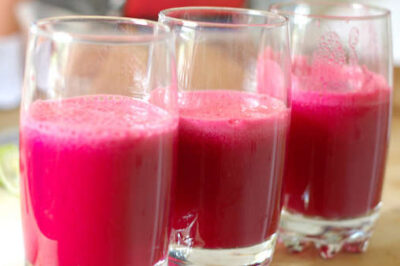Although I always tell people to eat their vegetables and fruit, there are at least three reasons why juicing is important and should also be included in the diet.
First, we can juice far more produce than we would probably eat in a day. It takes a long time to chew raw veggies! Chewing is a very good thing, and I highly encourage it. However, we have only so much time for chewing up raw foods.
One day I timed how long it would take for me to eat five medium-size carrots. (That’s what I often juice along with cucumber, lemon, ginger root, beet, kale and celery.) It took about 50 minutes to chew them up and swallow them. Not only do I not have that kind of time every day, but my jaw was also so tired afterward that I could hardly move it.
Second, we can juice parts of the plant we would not normally eat, such as stems, leaves and seeds. I juice things I know I would rarely or never eat such as beet stems and leaves, celery leaves, the white pithy part of the lemon with the seeds, asparagus stems, broccoli stems, the base of cauliflower, kohlrabi leaves, radish leaves and ribs of kale.
Third, juice is broken down so it spares digestion. It is estimated that it is at work in the system within 20 to 30 minutes. For ailments such as thyroid disorders, juice is therapy for this very reason. When the body has to work hard to break down veggies, it can spend a lot of energy on the digestive process. But juicing does the work for you. When you drink a glass of fresh juice, all those life-giving nutrients can go to work right away to heal and repair your body, giving it energy for its work of rejuvenation.
People often ask me if it takes a bushel basket full of produce to make a glass of juice. Actually, if you’re using a good juicer, it takes a surprisingly small amount. For example, five to seven large carrots or one large cucumber yield about one 8-ounce glass of juice.
The following amounts of produce each yield about 4 ounces of juice: one large apple, three to four large (13-inch) ribs of celery, or one large orange. The key is to get a good juicer that yields a dry pulp. I’ve used juicers that ejected very wet pulp. When I ran the pulp through the juicer again I got more juice and the pulp was still wet.
Adapted from Cherie Calbom’s The Juice Lady’s Remedies For Thyroid Disorder (Charisma House, 2015).
Cherie Calbom, M.S., C.N., is the author of more than 20 books, including The Juice Lady’s Big Book of Juices and Green Smoothies and Remedies for Stress and Adrenal Fatigue. She holds a Master of Science degree in whole foods nutrition from Bastyr University. Cherie and her husband, John, offer juice health retreats throughout the year, along with health and healing conferences. For more information, visit juiceladycherie.com.








Leave a Comment
You must be logged in to post a comment.